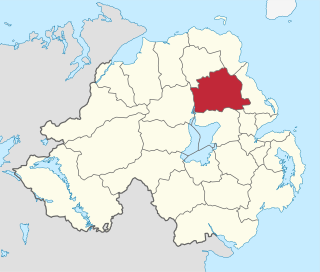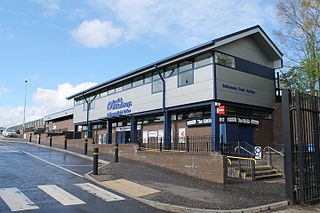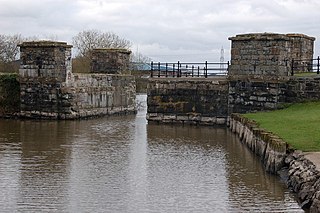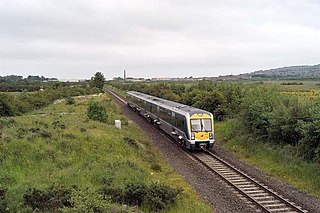Related Research Articles

Ballymena is a former local government district with borough status in Northern Ireland. It was one of twenty-six districts created on 1 October 1973 and covered the town of Ballymena and the surrounding area which includes small towns including Broughshane, Cullybackey, Galgorm, Ahoghill and Portglenone. The borough had an area of 200 square miles (520 km2) and a population of 64,044 according to the 2011 census. The borough had a central location within Northern Ireland and was served by the M2 motorway and with a station on the Belfast-Derry/Londonderry railway line. Belfast International Airport itself was only 18 miles (29 km) away and the Belfast City Airport is 30 miles (48 km) from Ballymena. It was also accessible to the seaports of Larne and Belfast, 20 and 27 miles (43 km) away respectively. As of 2015 it has been replaced by Mid and East Antrim Borough Council.

The Northern Counties Committee (NCC) was a railway that served the north-east of Ireland. It was built to Irish gauge but later acquired a number of 914 mm narrow gauge lines. It had its origins in the Belfast and Ballymena Railway that opened to traffic on 11 April 1848.

York Road railway station served the north of Belfast in Northern Ireland. It was formerly one of the three terminus railway stations in Belfast. The others were Great Victoria Street, and Queen's Quay.

Ballymena is a town in County Antrim, Northern Ireland. It had a population of 29,551 people at the 2011 Census, making it the eighth largest town in Northern Ireland by population. It is part of the Borough of Mid and East Antrim.

The Belfast–Derry line runs from Belfast to Derry in Northern Ireland. The line is double-track on the short section it shares with the Belfast–Larne line, but is composed primarily of single track from Monkstown to Derry with passing points at Templepatrick, Antrim, Magherabeg, Ballymena, Killagan, Ballymoney, Coleraine and Bellarena.

Ballymena railway station serves the town of Ballymena in County Antrim, Northern Ireland. It is located just outside Ballymena town centre on the Galgorm Road, and is integrated with the local bus station. It is situated on the Derry line between Antrim and Cullybackey. The station is operated by Northern Ireland Railways.
The Dunmurry train bombing was a premature detonation of a Provisional Irish Republican Army (IRA) incendiary bomb aboard a Ballymena to Belfast passenger train service on 17 January 1980.

Templepatrick railway station served the village of Templepatrick in County Antrim on the Belfast-Derry railway line.
Castledawson railway station was on the Belfast and Ballymena Railway which ran from Cookstown Junction to Cookstown in Northern Ireland.
Magherafelt railway station was on the Belfast and Ballymena Railway which ran from Cookstown Junction to Cookstown in Northern Ireland.
Moneymore railway station in Moneymore, County Londonderry, was on an extension of the Belfast and Ballymena Railway which ran from Cookstown Junction in County Antrim to Cookstown in County Tyrone in Northern Ireland.

Toome Bridge railway station was on the Belfast and Ballymena Railway which ran from Cookstown Junction to Cookstown in Northern Ireland. Located in Toome in County Antrim on the River Bann with County Londonderry across the river.
Staffordstown railway station was on the Belfast and Ballymena Railway which ran from Cookstown Junction to Cookstown in Northern Ireland.

Randalstown railway station was on the Belfast and Ballymena Railway which ran from Cookstown Junction to Cookstown in Northern Ireland.

Cookstown Junction railway station served the townland of Drumsough outside Randalstown in County Antrim, Northern Ireland. It was a single island platform at the junction of the Cookstown extension to Magherafelt, Cookstown, Draperstown and Macfin.
Dunadry railway station served the hamlet of Dunadry and was on the Belfast and Ballymena Railway which ran from Belfast to Ballymena in Northern Ireland.

Doagh railway station served the village of Doagh in County Antrim, Northern Ireland.

Ballyclare Junction railway station was on the Belfast and Ballymena Railway which ran from Belfast to Ballymena in Northern Ireland. Despite the name, the physical junction for the branch line to Ballyclare was located a short distance along the line in the Antrim direction, at Kingsbog Junction.
Whitehouse railway station was on the Belfast and Ballymena Railway which ran from Belfast to Ballymena in Northern Ireland.
Greencastle railway station was on the Belfast and Ballymena Railway which ran from Belfast to Ballymena in Northern Ireland.
References
- ↑ "Staffordstown station" (PDF). Railscot - Irish Railways. Retrieved 29 April 2012.